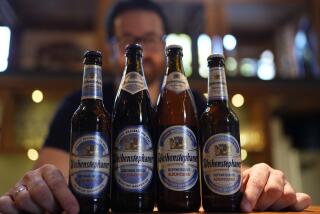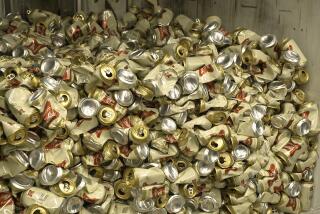Absinthe trickling back into the U.S.
- Share via
Absinthe, an intense alcoholic spirit favored by artists such as Degas, Van Gogh and Hemingway, is making a comeback in the U.S. after being banned by the government for almost 100 years.
Its rebirth in trendy restaurants and bars is a triumph of marketing -- and of maneuvering through a maze of federal rules on formulas and labels. It took a Swiss distiller, an importer and a Washington attorney four years to navigate the bureaucracy, even after the drink was legalized again in Europe.
“This is a complex issue, and we are addressing it as best we can,” said Art Resnick, a spokesman for the U.S. Treasury Department’s Alcohol and Tobacco Tax and Trade Bureau, referring to the process that led this year to the agency approving four absinthe brands for sale in the U.S.
For much of the 19th and early 20th centuries, the typically green liquor, also known as the Green Fairy, was wildly popular among artists in Europe. It was the subject of the Edgar Degas painting “L’Absinthe.” Emile Zola mentioned it in a novel and Ernest Hemingway wrote: “Got tight last night on absinthe. Did knife tricks.”
Absinthe was believed to hold large concentrations of wormwood, a plant containing the chemical thujone, which could induce hallucinations and a drug-like state. It was thought to be the source of Van Gogh’s impulse to cut off his ear.
Imports of absinthe were banned by the U.S. Department of Agriculture in 1912 because other countries had outlawed it. Later, a Food and Drug Administration rule requiring that products be “thujone-free” kept it off the market.
The whiff of illegality made absinthe all the more desirable. Groups like the Wormwood Society kept the mystique alive. It was bootlegged, sold widely over the Internet and smuggled in by travelers.
Once bans on the liquor were lifted in Europe in the 1990s, the campaign began in the U.S. to restore absinthe to the cocktail menu. The stakes were high for brand owners and importers. The winner would have a head start on marketing the drink, which costs $50 to $60 a bottle.
Robert Lehrman, a Washington attorney who specializes in seeking formula and label approvals at the Tax and Trade Bureau, said the government “worked hard to keep the genie in the bottle.”
Lehrman, representing an importer and Distillerie Kubler & Wyss of Motiers, Switzerland, cited endless quibbles by regulators. The biggest blow, he said, was last year when the bureau flatly rejected the label on the grounds that absinthe was still illegal.
Approval for Swiss Absinthe Superieure Kubler, 106 proof, was granted on May 17.
Kubler’s success was diluted when a competitor, Lucid, Absinthe Superieure, 124 proof, was available in the stores the same month, after being approved in March.
Both brands met the government’s “thujone-free” standard, meaning each contains less than 10 parts of the chemical per million. Exactly how much thujone each formula includes, if any, is a trade secret.
Jared Gurfein attracted publicity for his Lucid brand when he abandoned a law career to start Viridian Spirits in Manhasset, N.Y., to make and distill absinthe.
Gurfein also knew “Kubler had hit a brick wall” with regulators, he said.
“We pushed the door down and they walked through it,” Lehrman said, expressing frustration with the red tape he faced.
In the meantime, the marketers have taken over.
“This is so easy,” said Lyons Brown, chief executive of Altamar Brands in Corona del Mar, distributor for Kubler. “The key is to just get it into the market with all the theatrics that go with it.”
More to Read
Eat your way across L.A.
Get our weekly Tasting Notes newsletter for reviews, news and more.
You may occasionally receive promotional content from the Los Angeles Times.







